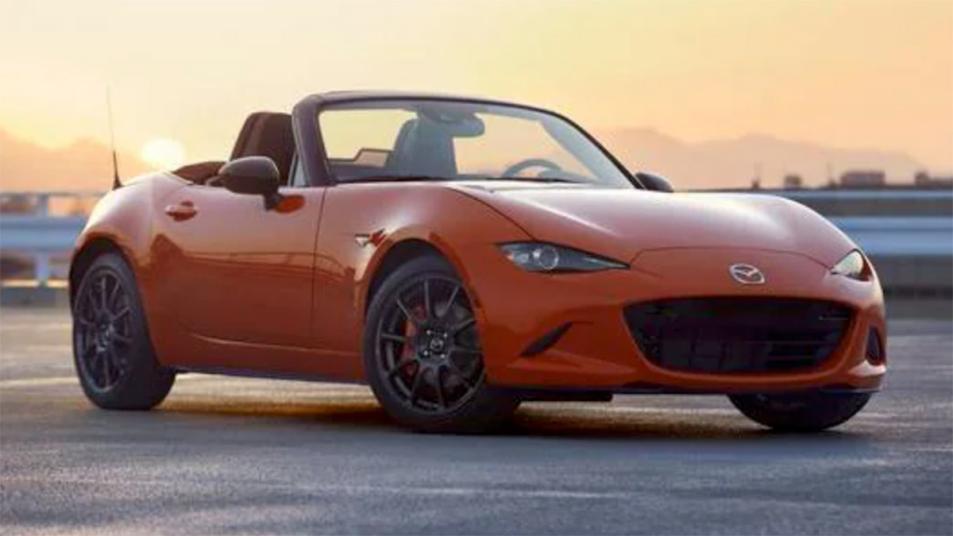If you’re considering buying a Mazda Miata, you’re likely drawn to its iconic design and thrilling driving experience. However, not all Miata years are created equal.
Some models have unique quirks or issues that could affect your joyride. Knowing which Miata years to avoid can save you from unexpected headaches and help you make a smarter purchase. Imagine cruising down the open road with peace of mind, confident that you’ve made the right choice.
In this guide, you’ll discover the specific years that might not meet your expectations, helping you steer clear of potential pitfalls and ensuring every drive is as exhilarating as you’ve imagined. Stay tuned to make sure your Miata experience is nothing short of extraordinary.

Credit: www.motorbiscuit.com
Early Model Concerns
When you think of the Mazda Miata, often the first image that comes to mind is the sleek, zippy convertible that offers pure driving joy. However, not every Miata is created equal, especially when you consider the early models. These early versions, while iconic, come with their fair share of quirks that might make you pause before buying.
Let’s dive into some of the key issues you should be aware of, especially if you’re eyeing these classic models.
Engine Issues
Early Miata models, particularly those from the late ’80s and early ’90s, sometimes face engine problems. A common issue is the short nose crankshaft. This design flaw can lead to crankshaft pulley failures and timing issues. Imagine the frustration of planning a weekend road trip only to find your Miata can’t keep up! It’s crucial to check if this issue has been addressed in any Miata you’re considering.
Another concern is oil leaks. These can be quite pesky and lead to bigger problems if ignored. Regular maintenance and vigilant checks are key. Consider how much time and money you’re willing to invest in upkeep. Is the allure of an early Miata worth the potential headache?
Rust Problems
Rust is the silent enemy of many classic cars, and the Miata is no exception. Early models are notorious for rust, especially in areas like the sills, wheel arches, and underneath the car. It might look pristine on the surface, but a thorough inspection is always necessary. Have you ever fallen in love with a car’s exterior only to find its underbelly is less than perfect?
Consider the climate of where the car has spent most of its life. Cars in areas with heavy snowfall and road salt are particularly vulnerable. You might want to avoid early models from such regions unless you’re prepared to tackle rust repair. Are you ready for the commitment?
In conclusion, while early Miatas have their charm, knowing their potential pitfalls can save you from future headaches. With careful consideration, your Miata journey can be smooth and enjoyable.

Credit: www.autotrader.com
Second Generation Challenges
The second generation Mazda Miata, also known as the MX-5 NB, offers a mix of charm and challenges. Produced from 1998 to 2005, this model is adored by enthusiasts for its classic roadster feel. Yet, it’s not without its flaws. Owners often encounter issues that can affect performance and driveability.
Suspension Flaws
The second generation Miata has suspension issues that can be frustrating. Many drivers report a rough ride on uneven surfaces. The factory setup may feel too soft, impacting handling during turns. Over time, the suspension components might wear out, leading to costly repairs. Regular maintenance can help, but understanding these flaws is crucial for potential buyers.
Transmission Troubles
Transmission problems are another concern with the MX-5 NB models. Some owners experience difficulties when shifting gears. The manual transmission may feel sticky or unresponsive at times. Wear and tear can lead to grinding noises during gear changes. These issues can affect the driving experience significantly. Checking the transmission before buying can save future headaches.
Third Generation Woes
The third generation of the Mazda Miata, known for its sleek design, has its share of issues. It ran from 2005 to 2015 and brought some notable challenges. Owners reported problems that affected the driving experience. These issues can make maintenance a hassle. Understanding these troubles can help potential buyers make informed decisions.
Electrical System Bugs
Many owners experienced electrical system problems. Faulty wiring often caused erratic dashboard lights. This left drivers puzzled and frustrated. Sometimes, the battery drained unexpectedly. This problem left cars unable to start. It also led to costly repairs for some. The root cause was often traced to poor connections. Checking the wiring regularly might prevent this.
Interior Wear
The third generation’s interior suffered from rapid wear. Seats showed signs of damage after short use. Upholstery faded quickly under the sun. This led to a shabby appearance in many cars. Dashboard materials also aged poorly. They cracked and lost their finish, diminishing the cabin’s appeal. Regular care can help, but damage often occurs early.

Credit: www.motorbiscuit.com
Fourth Generation Shortcomings
The fourth-generation Miata has a few hiccups to watch for. Some issues include transmission problems and a noisy cabin. It’s wise to research specific years before purchasing to avoid potential headaches.
The fourth generation of the Mazda Miata, often known as the MX-5, has garnered attention for its sleek design and performance. Yet, it faces some criticism. Enthusiasts have pointed out certain shortcomings. These issues may influence potential buyers’ decisions.Technology Glitches
The fourth generation Miata’s technology can be problematic. Some users report infotainment system issues. The touch screen sometimes freezes or lags. Connectivity with smartphones can be unreliable. Drivers may face pairing challenges with Bluetooth. Navigation systems also have occasional glitches. These tech issues can frustrate drivers.Build Quality
Build quality concerns exist for the fourth generation Miata. Some owners notice inconsistent panel gaps. This affects the car’s visual appeal. Interior materials feel less durable to some. Wear and tear appear quicker than expected. Noise insulation is another concern. Road noise enters the cabin easily. This affects the driving experience.Common Problems Across Generations
Certain Miata models face recurring issues. Rust problems haunt early years. Transmission troubles affect certain newer models. Engine reliability varies across generations.
When considering a Mazda Miata (MX-5), it’s crucial to be aware of the common issues that have persisted across its various generations. While the Miata is celebrated for its sleek design and exhilarating driving experience, like any car, it has its own set of challenges. Whether you’re eyeing a classic NA model or a more recent ND, understanding these potential pitfalls can save you from future headaches.Cooling System Failures
One common issue across the Miata generations is the cooling system failures. Overheating can lead to severe engine damage if not addressed promptly. In some models, the radiator may develop leaks, especially in older vehicles. It’s important to regularly check for any signs of coolant leakage or unusual temperature fluctuations. Replacing a faulty radiator or thermostat early can prevent bigger problems down the road. Have you ever considered investing in an aftermarket radiator for better durability?Paint Durability Issues
Another concern among Miata enthusiasts is the durability of the paint. Over time, the paint can fade, especially if the car is frequently exposed to harsh weather conditions. Some owners have noted that certain colors and models are more prone to chipping and peeling. Regular waxing and using a car cover can help preserve the paint’s appearance. Have you thought about a protective film to shield your Miata’s vibrant color? It could be a worthwhile investment for maintaining that showroom shine. When purchasing a Miata, understanding these common problems can make all the difference. It equips you with knowledge to ask the right questions and make informed decisions. What steps will you take to ensure your Miata remains in top condition?Expert Tips For Buyers
Certain Miata models have issues worth noting. Early 1990s models often face rust problems. The 1999-2000 versions sometimes have engine failure. It’s essential to research thoroughly before buying to avoid costly repairs.
Are you eyeing a Mazda Miata (MX-5) but feeling overwhelmed by the numerous models and years available? You’re not alone. Many potential buyers are keen to get behind the wheel of this iconic roadster, yet worry about picking a model with hidden issues. Here’s a guide filled with expert tips to help you navigate the buying process confidently. Whether you’re a seasoned car enthusiast or a first-time buyer, these insights will steer you in the right direction.Inspection Checklist
An inspection checklist can be your best friend when evaluating a Miata. Start with the exterior. Look for signs of rust, especially around the wheel wells and undercarriage. Don’t forget to check the convertible top for any tears or leaks. Move on to the interior. Ensure all electronics, from the radio to the window controls, are in working order. Pay attention to the condition of the seats and the dashboard. A well-maintained interior often reflects how the car has been treated overall. The engine is where you need to be extra vigilant. Listen for unusual noises during a test drive. Check the oil and transmission fluid levels. If possible, take the car to a trusted mechanic for a thorough inspection. It might cost a bit upfront, but it could save you from costly repairs down the road.Maintenance Advice
Regular maintenance can keep your Miata running smoothly for years. Start by changing the oil every 3,000 to 5,000 miles. This simple step can prolong engine life significantly. Keep an eye on the tires. They not only affect fuel efficiency but also your safety. Rotate them every 6,000 to 8,000 miles and check for any signs of wear or damage. Don’t overlook the importance of a clean air filter. It helps your engine run efficiently and should be replaced every 15,000 to 30,000 miles. Also, ensure the brake pads are in good condition. Worn-out brakes can be dangerous and lead to more extensive damage if ignored. Would you invest in a used Miata if it required a bit more maintenance upfront? Sometimes, a little TLC can turn a neglected car into a treasured companion. Remember, a well-cared-for Miata can offer a thrilling ride and peace of mind.Conclusion
Choosing a Miata is fun but requires careful thought. Some years might have issues. Knowing these helps avoid problems. Researching your options saves time and money. Understanding the common issues is key. Check the specific year’s reviews. Talk to owners.
They share valuable tips. A well-informed choice brings joy. Enjoy the ride with peace of mind. Make the right decision. Drive a Miata that fits your needs. The right model offers endless fun. Your perfect Miata awaits. Happy driving!



